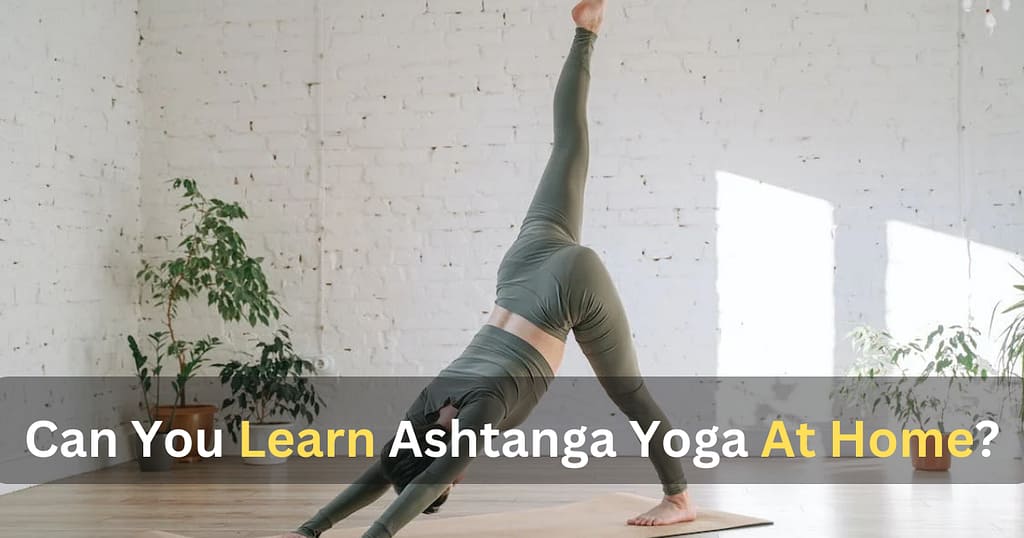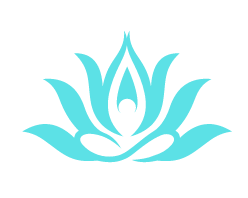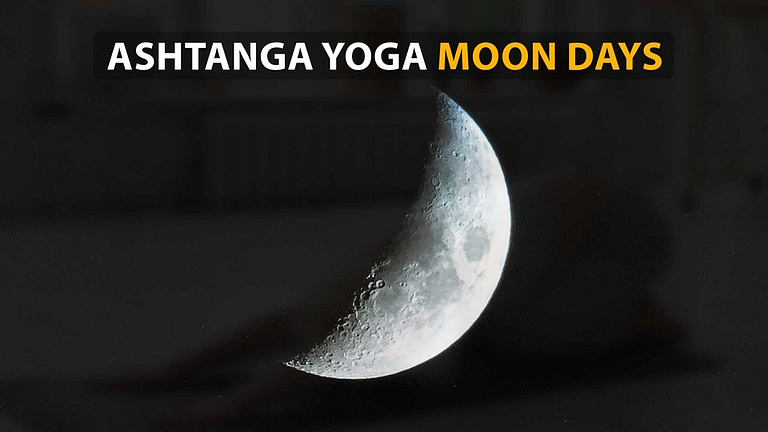Can You Learn Ashtanga Yoga At Home? – Complete guide in 2023

Can You Learn Ashtanga Yoga At Home?
Yes, you may practice Ashtanga yoga without an instructor at home. But, before you can do anything alone, there are a few things you need know. Continue reading to learn more about these hints.
Students do their Ashtanga yoga exercises at home with this method. They might have learned it from a teacher or something else, like a book or a movie. Many of the people who answered said they practiced at home some days a week and went to a private class one or more days a week.
Practicing Ashtanga yoga at home can be a great way to get the benefits of this powerful type of yoga without paying for a school class or spending a lot of time there.
Ashtanga yoga is an old style in which yogis can do some poses in time with their breath. It’s a great way to get more robust, flexible, aware, and focused.
Here are some things you’ll need to get started if you want to do Ashtanga yoga at home
1. A gap
Ensure you have enough space to move around and find a comfortable place to practice at home.
2. Kudos
You might want to buy yoga tools like blocks, blankets, and straps to make it easier and safer to get into the poses.
3. A guide for use
Some online guides and DVDs will help you learn the Ashtanga routine and how to move through the poses correctly.
4. A school teacher
If you can, having an experienced teacher watch your practice and give you feedback daily is best. Even if you can’t find a teacher in person, many online classes can help you stay on track.
Once you know how to do the basics, it’s time to start practicing! Traditionally, Ashtanga is done six days a week, with one day off.
You must complete Sun salutations (Surya Namaskara A and B) five times to start the practice, and then standing poses, sitting poses, backbends, and inversions are done. Before moving on to the next pose, each pose is for at least five breaths.
Keep your body and breath in mind as you exercise. Pay attention to how each pose feels, and if you need to, change your form. Listen to your body and take breaks when you need to.
With regular exercise, you’ll soon start to feel the benefits of Ashtanga yoga, such as improved strength, flexibility, and mental clarity. So, why don’t you do it? Start doing Ashtanga yoga right away and see how powerful it is.
Can you learn Ashtanga Yoga Online?

I like giving online Ashtanga classes more than in-person classes because I see better results. It works better. I was also surprised. Why were the kids I had taught for years improving their skills now that I was teaching from a computer?
At first, it didn’t make sense. In Mysore, people usually think that a book or film can’t take the place of an absolute master. This is not true, though. Instead, the physical presence of a natural teacher and real class can often distract, confuse, and otherwise hinder a person’s learning process.
THREE REASONS WHY I THINK SO:
- The student is no longer affected by the competitive and comparing aspects of being in an actual class with other people.
- The student has to take much more responsibility for their practice now that they can’t depend as much on the group’s energy. This pushes the person and makes them more robust, focused, and committed.
- The student is so much less affected by the teacher’s personal feelings and biases about how they should practice.
Read:
Does Ashtanga Yoga Help You Lose Weight? – A Comprehensive Analysis In 2023
How To Practice Ashtanga Yoga Without A Teacher

1. Find the drive to practice by yourself every day
The main problem with practicing without a guide is getting past laziness and finding the drive. Anyone who has practiced yoga in a yoga shala may have noticed that the room’s energy was sometimes enough to help them get through their practice.
This was something I loved about my yoga shala. At 7 a.m., I would still be half asleep when I walked into the room. Still, it was enough for me to see my fellow practitioners and watch them work.
The other thing that pushed me was, of course, the fact that my teacher was there. Her calm presence was there to help me find my way and make changes when I needed to.
So, when I moved, I had to practice by myself. This meant I had to remember how that special place made me feel and use that to keep me going.
It can be not easy. It’s different to practice yoga by yourself.
Over time, you learn to remember your teachers’ presence and practice as if they were there. And then, as time goes on, you teach yourself. You keep going, change your poses independently, and develop new practice methods.
You can do it by getting pictures or movies, keeping a calendar, or doing what I do: promise myself that I will at least do the sun salutations.
So, even if I don’t do a full practice, I will at least put my mat down. Even that is something a home practitioner can be proud of.
2. Make sure your practice is safe
Ashtanga yoga is an exercise that is hard on the body. This means that we move our bodies into many positions that help us become more robust and flexible. Because of this, it is imperative to practice in a way that is kind to our bodies and helps us keep doing this for the rest of our lives.
Everyone who is just starting should work with a teacher. The reason is that a teacher will be able to see if any poses or moves could hurt someone.
This is usually shown by where the shoulders are in chaturanga (we drop the shoulders as we come down from the plank) or where the hands are in a downward-facing dog. In the long run, these small things can help keep people from getting hurt.
So, if you are new to Ashtanga, I would tell you to try to start with a master. If there aren’t any teachers near you, try going somewhere else, even if it’s just for an individual class or training. And use the help they give you in your work.
3. Have a place where you can do yoga
Find a place that’s big enough for your yoga mat. No matter how small it is, this should feel warm and safe. Keep your yoga area clean and free of things that might get in the way. You could also make it more special by adding a light or a piece of art.
Another piece of advice is to get rid of all distractions, especially cell phones. Move them to another room while you practice so that you can keep your mind on your practice.
4. Pay attention to a critical pose
- Even in Ashtanga yoga, you can change how you pose. This means we keep the same poses but change them up more. For example, you could work on backbends one day and inversions the next. It’s your practice, so do what you think is right.
- We want to keep our Ashtanga yoga practice the same and maintain the general set routine, which should go without saying. But if it feels right to focus on essential parts of the method on some days, do that.
- Use variety and give yourself the freedom to change things up. For example, you could focus on one type of asana (like backbends or forwardbends), stay in your poses longer, do fewer asanas, or go faster and do more asanas.
Garrigues, David
There is no right or wrong if we stay within the limits of our practice by focusing on Drishti, bandhas, and breath. It’s just what makes sense for you at that moment.
5. Change it up now and then
Ashtanga yoga tends to look down on people who do other kinds of yoga. It makes sense since we want to keep our practice constant and focus more on the moving meditation part while building the strength and flexibility we’ll need for the next set of poses.
Read:
What Is Special About Ashtanga Yoga? – 14 Benefits Of Ashtanga Yoga
Ashtangis only do yoga, which is called “Ashtanga.” Is that right?

Well, I’m afraid I have to disagree as a home practitioner. There are times when I practice Ashtanga. There are also times when I do other kinds of yoga. So far, that has worked out well for me.
This could be because it gives me the drive to keep practicing and makes me feel more calm.
For example, sometimes I like to do a yin yoga practice, and sometimes I want to do a vinyasa flow exercise. There are even times when I’d rather ride a bike or do a more cardiovascular workout.
I’ve seen two things, in fact:
- When I do a cardio workout, my Ashtanga practice seems easy and lighter the next day. This could be because my cardio workout gives me more strength and stamina, which I can use in my Ashtanga practice.
- When I do an exercise like yin yoga, I feel more flexible the next day when I do Ashtanga. This could be because I’ve stretched out the connective tissue in parts of my body that don’t usually get stretched.
So, figure out what works for you!
1. Bring any exercise tools you might need
Some more traditional Ashtanga teachers don’t like it when people use props. Still, you are your teacher at home, so you can use them to your advantage and focus on things you may be having trouble with. Just try not to get in the way of things too much.
Some yoga tools are:
- You can use yoga blocks to help you with your jumpbacks.
- Straps that can help you hold your leg in Uttitha Hasta Padangustasana, the first balance pose.
- You can use yoga wheels to open your back and prepare for backbends.
2. Know when and how to move on to the next pose.
In Ashtanga yoga, knowing when to move on to the next pose can be essential because we are sometimes judged on our posture. The best way to know when to move on is to ask a master who understands your practice, but there is a rule of thumb. When you’re good at one pose, you can move on to the next.
- For newbies, it’s best to do sun salutations and the three poses at the end. Once you’re good at that, add the standing positions slowly.
- If you’ve been doing yoga for a while, you may know how to listen to your body better than someone just starting. Make sure you’re comfortable in the poses you can do. This means that you should be able to stay in each pose easily for five long breaths.
- There are some poses where you have to bind. Here are the four Marichyasana poses (A, B, C, and D) and Supta Kurmasana. Before moving on to the next pose, we should be able to bind alone in each of these.
- To feel the bind, you should get creative with a yoga strap. Then, give your body time to begin to change slowly.
- Kino McGreggor’s lessons are beneficial if you want to learn more about how to do specific asanas. Check out her videos on YouTube to learn how to do things.
3. Find a teacher you can go to.
After training alone for just one year, I was desperate to find a teacher I could go to. I had already been to Mysore and trained with Sharath Jois, so this became my yearly trip.
Every year, I spent one month in India training with my teacher in a room with 80 others. I love all of the memories I have from those trips.
Read:
Can Beginners Do Ashtanga Yoga? Complete Guide In 2023
Conclusion
Practicing Ashtanga yoga at home is good for you in many ways. But many people also need help to keep up with daily exercise. It takes a lot of self-control to show up on the mat when no one is watching.
So why did Ashtangis choose to train at home? Scheduling was the main reason people gave for picking home practice.
The second most common reason was that no local teacher or the student’s chosen teacher needed to be local. Third, practitioners decided on home practice because it was better for them in many ways.
Some people liked being alone. Some people thought that practicing at home gave them more freedom to change the way they practiced in some way. Lastly, some people said that the price of studio classes made them want to practice at home.
FAQs
Q: Can Ashtanga be self-taught?
When people talk about Ashtanga yoga, they often speak of self-practice and classes led by an instructor as if they were two different things.
Q: Can anyone start Ashtanga yoga?
Yes, learning yoga in Mysore, where Ashtanga yoga is taught, is a great way to learn yoga. Still, we need help with more than just the beginning of something.
Q: Can anyone do Ashtanga yoga?
Even the most rigid person can do it.
video guide:
read also
- Ashtanga Vs Hatha Yoga – Which Form Of Yoga Is Best In 2023
- Ashtanga Opening And Closing Mantra – Complete Guide 2023
- Why Do I Feel Cold After Meditation? – Secret Behind In 2023
- Why Do I Feel Electrical Sensations After Meditation? – Unveiling The Reason Behind In 2023
- What Is The Mile 22 Finger Meditation Technique? – Complete Guide In 2023
- What Is Magnetic Pull During Meditation? – What You Need To Know In 2023






